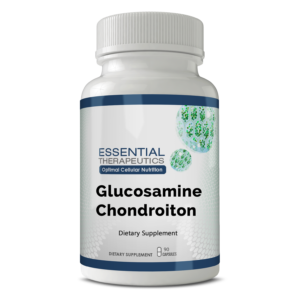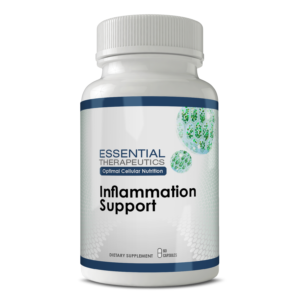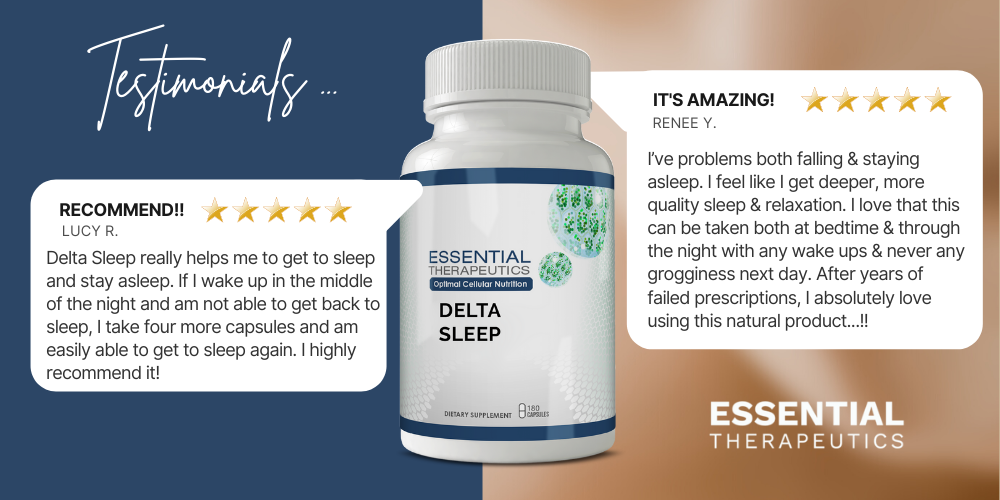Pain, Osteoarthritis, and Rheumatoid Arthritis
How the Inflammatory System WorksTrauma, infection, ischemia (reduced blood flow), toxins, poisons, and normal wear and tear cause damage and destruction to cells. This damage then triggers an orderly inflammatory response by the body’s self-regulating mechanisms.
Inflammatory Chemicals
The first group of chemicals, histamine, leukotriens, and pro-inflammatory hormones (prostaglandins), cause the blood vessels to dilate or expand. The dilation of the blood vessels causes the area to become hot, red and swollen. The healthy tissue surrounding the damaged area releases anti-inflammatory prostaglandins (PG1 and PG3) to combat the inflammatory prostaglandins (PG2). Certain chemicals (proteolytic enzymes) are responsible for telling the white blood cells that their job is done. These chemicals sound the alarm for the white blood cells to stop attacking and digesting cells and tissues.
Proteolytic enzymes are manufactured to squelch the white blood cells from continuing to eat up cellular debris. As the damaged cells and tissues are removed, less of the pro-inflammatory chemicals and more of the anti-inflammatory chemicals are released. Once the inflammation process is finished, the body begins to repair itself. The balance between inflammation, destruction, and repair is an ongoing process. Normally, this process is kept in check. When the process becomes unbalanced, chronic inflammation takes over. Inflammation is largely regulated by the prostaglandin hormones.
Prostaglandins
There are several different groups of prostaglandins, but inflammation is largely controlled by prostaglandin 1 (PG-1), prostaglandin 2 (PG-2), and prostaglandin 3 (PG-3).
Prostaglandins are a group of regulatory hormones produced in the body from fatty acids. Essential fatty acids are essential for our existence. They can not be manufactured by the body but must be obtained from the foods we eat. Essential fatty acids are made up of polyunsaturated fatty acids (PUFAs).
PUFAs are divided into two families of essential fatty acids (EFAs)1. Omega 3 oils, including alpha linolenic acid (ALA), are found in flax seed, soybean, walnut, and chestnut oils, as well as some dark green leafy vegetables. Eicosapentaenoic acid (EPA) and docosahexanoic acid (DHA) are omega 3 derivatives and are found in most cold water fish. These fish include salmon, tuna, and mackerel.
2. Omega 6 is found in pure vegetable oils, including sunflower, safflower, and corn oil. Some individuals are genetically unable to convert linoleic acid (LA) into its derivative, gamma linolenic acid (GLA). This can be overcome by taking primrose or borage oil; both are high in GLA.
Anti-Inflammatory Hormones
PG-1 and PG-3 are anti-inflammatory hormones. They help reduce and eliminate inflammation and pain. The best source for PG-1 and PG-3 is fish oil supplements or a diet high in cold water fish.
Arachidonic Acid (AA) PG-2
The pro-inflammatory (causes inflammation) hormone PG-2 is made from arachidonic acid (AA). AA is found in corn and corn oil products. Corn products are used as the prominent foodstuff in westernized livestock. Read meat and pork products have a high AA content.
Arachidonic acid is derived from the consumption of land-animal foods (meats, cheese, eggs, etc.). Arachidonic acid stimulates the production of inflammatory chemicals including leukotriens (notorious in causing allergic reactions), thromboxanes, and prostacylins. Several research articles have demonstrated that the more animal fats a human eats, the more arachidonic acid they have in their blood and cell membranes and the more likely to have inflammation. Conversely, a diet high in fish oils promotes less inflammation and a lower level of inflammatory chemicals.
The average AA/EPA of Americans is approximately 11:1. In patients with inflammatory conditions and neurological disorders, the AA/EPA ratio is 20:1 or more. An AA/EPA ratio of 1.5:1 is considered ideal. This is the ratio found in Japanese populations, which have the highest life expectancy and the lowest rate of cardiovascular disease.

Our inflammatory reactions and their chemicals are therefore largely determined by what foods (fatty acids) we eat. Since most Americans are carrying around at least 10–20 pounds of excess fat, it is no wonder that arthritis and other inflammatory diseases are out of control in our country.
The average adult weighs 150 pounds; 30% of this is fat. This means that on average a person is carrying around 45 pounds of inflammatory imbalanced fatty acids!
Reduce Red Meat, Dairy, and Vegetable oilsSince all grains, vegetable and seed oils, and corn-fed livestock have high AA levels, I suggest patients reduce these products. I recommend you reduce or avoid red meat, dairy and all vegetable and seed oil products. An increase in omega-6 fatty results in an increased risk of rheumatoid and other inflammatory-related illnessess.
Fish Oils ResearchSome studies have shown that supplementing with fish oils results in a dramatic reduction in a person’s leukotriens (one of the chemicals implicated in asthma and other allergic reactions) by 65%. This correlates with a 75% decrease in their clinical symptoms. Another fish oil study, involving rheumatoid arthritis sufferers (often treated with incredibly toxic and life threatening prescription drugs) who took 1.8 grams of EPA fish oil and reduced their saturated fats (land animal foods), showed significant improvement over and above a placebo.
Sixty percent of the US population is deficient in omega-3 fatty acids.
S-adenosyl-l-methionine (SAMe)Several studies involving SAMe and fibromyalgia patients yielded substantial improvement in over all pain levels (as well as depression). Dosage is up to 1,200 mg. daily on an empty stomach. I also recommend SAMe when other therapies fail.
S-adenosyl-l-methionine (SAMe) ) comes from the amino acid methionine and acts as a natural anti-inflammatory and blocks pain without the side effects associated with NSAIDs. SAMe helps boost serotonin and epinephrine levels. It also helps increase the production of endorphins. Endorphins are the bodies natural pain blocking chemicals and are more powerful than morphine. SAMe helps manufacture and repair cartilage components. A study of osteoarthritis patients compared SAMe with NSAID drugs in its ability to reduce pain. One double-blind study showed SAMe was superior to ibuprofen in the treatment of osteoarthritis.
DL-Phenylalanine
DL-Phenylalanine is a combination of the D and L form of the amino acid phenylalanine. This form of phenylalanine acts as a natural pain-reliever. DL-phenylalanine blocks the enzymes responsible for the breakdown of endorphins and enkephlins, substances within the body that help relieve pain. Endorphins are actually far more powerful than the drug morphine. Small cells throughout the nervous system, brain, spinal cord, and nerve endings are able to produce these morphine-like proteins that act as an appetite suppressant and mild stimulant.
Although caution is advised for individuals with high blood pressure, DL-phenylalanine is an effective supplement in treating musculoskeletal pains, including those associated with arthritis and FMS. Many of my fibromyalgia and chronic pain patients have benefited from DL-phenylalanine. A clinical study shows subjects taking DL-phenylalanine had a remarkable improvement in their condition. Improvements were seen in 73% of low back pain suffers, 67% with migraines, 81% with osteoarthritis, and 81% with RA. For pain control, or as an antidepressant, take 1,000–4,000 mg. twice a day on an empty stomach. Phenylalanine can elevate blood pressure, and very high doses can cause rapid heart beat. Start with a low dose and increase to higher doses only as needed—and only if no side effects are noticed.
Avoid Instant Coffee – Instant coffee contains substances that block the receptor sites for endorphins (natural pain blocking chemicals).
Rheumatoid Arthritis
Over 50 million Americans suffer from arthritis. It is associated with pain, stiffness, inflammation, and decreased range of motion. There are over 100 different forms of arthritis, with osteoarthritis the most common. Rheumatoid arthritis is an autoimmune disease in which the body actually attacks itself and antibodies develop in joint tissues and cause pain. Women are three times more likely to develop this arthritis than men.
What Causes It? The definitive cause of rheumatoid arthritis is not known. It appears to result from a dysfunction in the autoimmune system.
Symptoms
Rheumatoid arthritis usually affects the knuckles, wrists, elbows, and shoulders with painful, warm, red swelling. Unlike osteoarthritis, which tends to be unilateral (one sided), rheumatoid attacks joints bilaterally (both sides).
Traditional Arthritis Treatments• Nonsteroidal anti-inflammatories (NSAIDs) and analgesics such as aspirin, Tylenol, indocin, sulindac, tolectin, ibuprofen, Daypro, naprosyn, Celebrex, and Vioxx can cause intestinal permeability. They cover up the symptoms but do not address the cause, and they can actually cause further joint destruction.

• Corticosteroids are strong hormonal drugs that can have serious side effects: peptic ulcer, osteoporosis, diabetes, glaucoma, depression, acne, water retention and weight gain, insomnia, facial hair growth, hypertension, and depressed immunity.
• Methotrexate is an immune-suppressing drug used to treat psoriasis, psoriatic arthritis, adult and juvenile rheumatoid arthritis, and Reiter’s syndrome. It is a toxic therapy that can cause kidney failure and severe liver damage.
• Gold injections can cause serious side effects: damage to the liver and kidneys, stomach disorders, anemia, headache, neuritis, and ulcerations of the mouth and gums.
Avoid Nightshades – In one study 70% of those with arthritis reported relief from chronic pain over a period of seven years after eliminating all white potatoes, tomatoes, peppers (except black), eggplant, and tobacco.
Other Factors
Food allergies are common and are responsible for a wide variety of health problems! In fact, food allergies and intestinal permeability play a large role in causing and/or aggravating arthritis. Individuals with intestinal permeability are prone towards developing arthritis. A permeable, or leaky gut, allows fragments of intestinal bacteria to penetrate into the joints. These bacteria fragments may cause the body to release anti-bodies which then attack the joint tissue–a typical autoimmune response (typical of rheumatoid arthritis). Food allergies are now being implicated as one cause of rheumatoid arthritis.
Increased intestinal permeability allows undigested chemicals to leak out of the digestive tract and into the bloodstream. This triggers an autoimmune (allergic) reaction and can create pain and inflammation in any of the body’s tissues.
Fish Oil Reduces Rheumatoid Arthritis
Omega-3 deficiencies increase the risk of rheumatoid arthritis. Greenland Eskimos consuming diets high in omega-3 fatty acids (mostly from fish oils) rarely suffer from arthritis. In more than a dozen studies over the past decade, rheumatoid arthritis patients taking omega-3 oils drastically reduced their pain and stiffness.
Osteoarthritis
Sometimes wear and tear of the boney cartilage of the body causes bone spurs or calcium deposits to form on the ligaments surrounding the joint. This leads to inflammation, pain, and decreased joint motion. This is osteoarthritis (OA), also known as degenerative joint disease (DJD). OA first appears asymptomatically in the 2nd and 3rd decades but becomes universal by age 70. Almost all persons by the age of 40 have some signs of OA in their weight-bearing joints, but only a minority report any symptoms. Surveys show that over 40 million Americans have OA.
Causes
Osteoarthritis is usually caused by trauma or joint injury (wear and tear). Many of my patients can trace the onset of their arthritis to a car accident, but some don’t remember anything that could be causing their neck or low back pain. Some individuals develop osteoarthritis from repetitive motions, poor posture, or from simply carrying more weight than their joints can handle. Losing weight can often provide dramatic relief to those with weight-bearing osteoarthritis of the knees and hips. That’s because these joints bear loads 2.5–10 times a person’s weight. For a 200-pound individual, this can translate to one ton of pressure. Heredity also plays a role in osteoarthritis.
Hypothyroid and Osteoarthritis
Patients with hypothyroid have been shown to be at increased risk of developing osteoarthritis.
SymptomsOsteoarthritis is characterized by early morning stiffness or pain that eases up as the day goes on, only to return again in the evening. This form of arthritis generally affects the joints of the knees, hands, feet, and spine. It develops gradually over several years and usually doesn’t cause joint redness, warmth, or swelling like rheumatoid arthritis.
Nutritional Supplements for Osteoarthritis
 Glucosamine sulfate is an excellent approach to eliminating the destruction of osteoarthritis. A growing body of research supports the use of this natural supplement. Studies in Italy showed that glucosamine reduced arthritis symptoms by one half in 73% of the group, and 20% enjoyed total symptom relief.
Glucosamine sulfate is an excellent approach to eliminating the destruction of osteoarthritis. A growing body of research supports the use of this natural supplement. Studies in Italy showed that glucosamine reduced arthritis symptoms by one half in 73% of the group, and 20% enjoyed total symptom relief.
A Portugal study involving 1,208 patients and 252 physicians showed glucosamine to be quite effective in eliminating pain and stiffness caused by the disease.
A study of patients with osteoarthritis of the knee, performed at the National Orthopedic Hospital in Manila, Philippines, showed that patients who were administered glucosamine had an 80% reduction in pain. Other studies have demonstrated that glucosamine is more effective than ibuprofen (Motrin, Advil, or Nuprin) in relieving the symptoms of osteoarthritis.
Glucosamine is not only superior to NSAIDs such as ibuprofen it is also free of the side effects of most arthritic medications.
More importantly, glucosamine and chondroiten sulfate actually slow or arrest the destruction of cartilage.
Glucosamine, which is made up of glucose and the amino acid glutamine, actually helps repair damaged articular joint tissue. It does this by stimulating collagen cells within the articular cartilage to produce more proteoglycans. Proteoglycans are responsible for forming a protective netting within the articular cartilage, which helps prevent its destruction.
Dosage is 500 mg. three times daily. You should see improvement in three–four weeks. Treatment should continue for a minimum of three months and, since there are little or no side effects, long-term therapy is advisable.
Chondroiten sulfate is composed of a large number of sugar molecules. It attracts fluid into the proteoglygan molecules, and this fluid acts as a shock absorber. Chondroiten inhibits certain enzymes that can damage cartilage, while stimulating the production of proteoglycans and other molecules needed for healthy new cartilage growth.
A study conducted in France, showed patients who received three months of chondroiten therapy had actually repaired a significant portion of their degenerated joint tissues.
Dosage is 800–1,200 mg. daily. You should see improvement in three to four weeks. Treatment should continue for a minimum of three months and, since there are little or no side effects, long-term therapy might be advisable.
I use a specially designed Arthritis Formula for my arthritis patients which contain: Glucosamine sulfate 500mg (see above).
Chondroiten Sulfate 400 mg (see above).
Boswelia: One of the oldest herbs in Indian ayurvedic medicine. Studies show it to be a potent pain-relieving anti-inflammatory. Boswellia helps shrink inflamed tissue, build cartilage, increase blood supply, and repair damaged blood vessels.
Bromelain: A protein-digesting enzyme derived from pineapple. There is considerable research (over 200 medical journal articles) on its effectiveness in treating such conditions as inflammation, pancreatic insufficiency, and respiratory diseases. It blocks inflammatory chemicals called kinins. It also digests excess fibren, a chemical implicated in osteoarthritis, sciatica, ankylosing spondylitis, and scleroderma. As an anti-inflammatory, bromelain needs to be taken on an empty stomach. If taken with food, it acts as a digestive enzyme.
Curcumin: A perennial plant found in eastern Asia and parts of India. It is a popular arthritis remedy in India and a powerful pain-relieving anti-inflammatory. It is as strong as hydrocortisone without the side effects.
 Devil’s Claw A perennial vine native to South Africa. It is a potent anti-inflammatory and pain reliever. Studies in Germany have shown this herbal medication to be very effective in relieving lower back pain and associated sciatica.
Devil’s Claw A perennial vine native to South Africa. It is a potent anti-inflammatory and pain reliever. Studies in Germany have shown this herbal medication to be very effective in relieving lower back pain and associated sciatica.
Rheumatoid Arthritis Protocol • Important! Correct intestinal permeability if present. This is necessary in order to reduce inflammatory reactions.
Many of my patients have enjoyed a reduction or elimination of arthritic symptoms after repairing their leaky gut.
• Strongly consider food allergy testing. Rheumatoid arthritis was absent in prehistory, when cereals and dairy products were not part of a daily diet. Some researchers believe that our bodies have simply not yet adapted to our modern eating habits. The most common allergy producing foods include wheat, corn, dairy, beef, and nightshades.
• Avoid nightshade foods. These include tobacco, eggplant, bell peppers, tomatoes, and white potatoes. Nightshade foods have been linked to an increase in arthritis symptoms.
• Treat any yeast or bacterial overgrowth of the intestinal tract. If you suspect you may have a problem please read the chapter on yeast overgrowth.
• Supplement with omega-3 essential fatty acids. Research suggests that the therapy must be continued for a minimum of 4–12 weeks before results are seen, and large doses of these oils are needed for the desired result: 3,000–9,000 mg. of fish oil (EPA/DHA).
• Supplement with digestive enzymes, hydrochloric acid, and pancreatic enzymes (pepsin, amylase, lipase, etc.) with each meal. I recommend everyone with FMS or CFS take a digestive enzyme with each meal.
• Exercise to keep the joints moving. Walking on a daily basis helps keep you limber and fit. Many of the back pain patients that I see are shocked to discover that they can severely reduce or eliminate the back problems they’ve had for years by simply walking 30–60 minutes a day.



